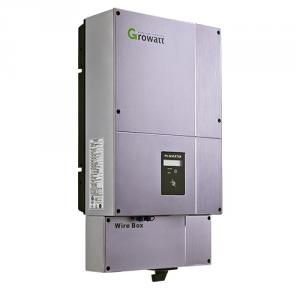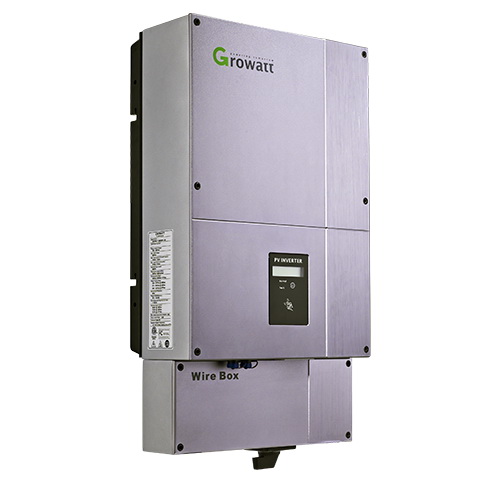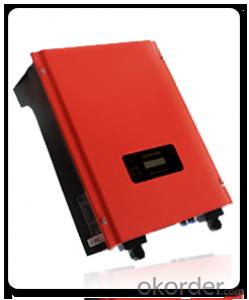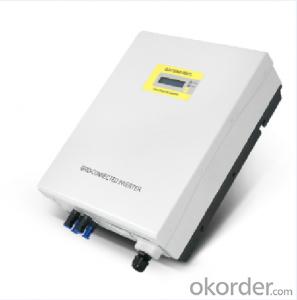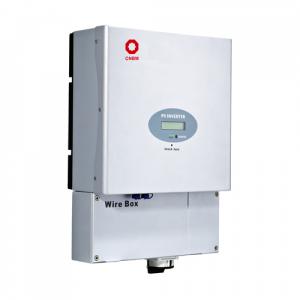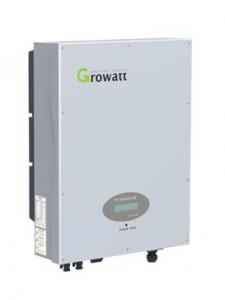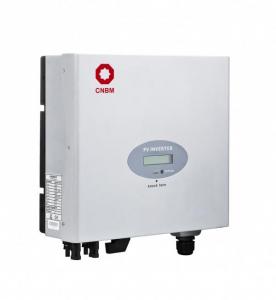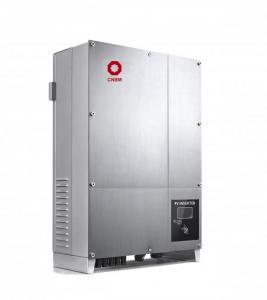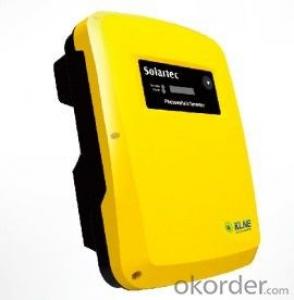Biggest Solar Inverter 3600MTL-US 5000MTL-US ETL FCC
- Loading Port:
- Shekou
- Payment Terms:
- TT OR LC
- Min Order Qty:
- 10 watt
- Supply Capability:
- 10000 watt/month
OKorder Service Pledge
OKorder Financial Service
You Might Also Like
Solar Inverter 3600MTL-US-5000MTL-US, ETL FCC
Specifications
Maximum efficiency over 97.8%
MPP control
MTL-String
RS485 RS232 bluetooth DC-switch
VDE 0126-1-1,IEC 62109,RD 1663,G83
3600 4200 5000 MTL-US
General Descriptions
Leading-Edge Technology
> Maximum efficiency of 97.9 % and wide input voltage range
> Internal DC switch
> Transformerless H6 topology
> Compact design
> Muti MPP controller
> MTL-String
> Bluetooth technology
> Easy installation
> Sound control
Communications
> RS485 /RS232/GPRS interfaces
> Computer monitoring software
Safety
> Full protection functions:DC reverse polarity, AC short-circuit protection, ground fault monitoring, grid monitoring, integrate all-pole sensitive, leakage current monitoring unit.
> Standards complied: Ul1741, UL1998, IEEE1547, CSA C22.2 No.107.1,FCC Part15(Class A&B)

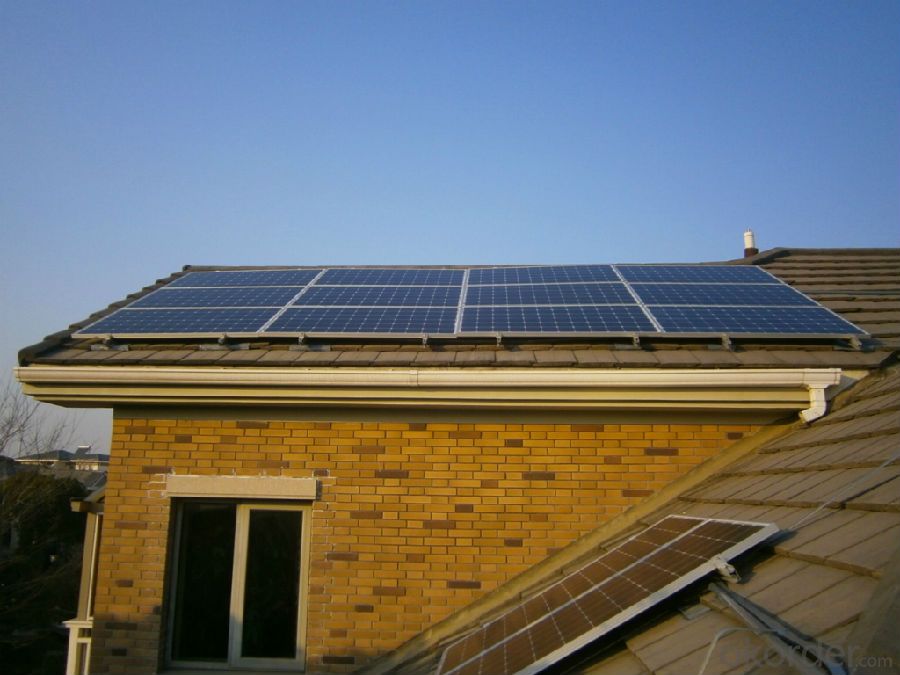
Technical Specifications
Model Specifications | 3600MTL-US | 4200MTL-US | 5000MTL-US |
Input data | |||
Max. DC power | 3800W | 4400W | 5200W |
Max. DC voltage | 600V | 600V | 600V |
Start voltage | 150V | 150V | 150V |
DC nominal voltage | 360V | 360V | 360V |
PV voltage range | 100V-600V | 100V-600V | 100V-600V |
MPP voltage range | 120V-550V | 120V-550V | 120V-550V |
Number of independent MPP trackers/strings per MPP tracker | 2/2 | 2/2 | 2/2 |
Max. input current of the MPP tracker | 12A | 15A | 15A |
Output data | |||
Nominal AC output power | 3600W | 4200W | 4600W |
Max. output current | 18/17.1A/14.8A | 21A/20A/17.2A | 22A/23.7A/20.5A |
AC nominal voltage; range | Default:240V single phase optional:208,240or277 single phase 183-228@208V 211-264V@240V 244-305@277V | ||
AC grid frequency; range | 60Hz;59.3-60.5Hz | 60Hz;59.3-60.5Hz | 60Hz;59.3-60.5Hz |
Phase shift (cosφ) | 1 | 1 | 1 |
THDI | <3%< p=""> | <3%< p=""> | <3%< p=""> |
AC connection | Single phase | Single phase | Single phase |
Efficiency | |||
Max. efficiency | 98% | 98% | 98% |
CEC efficiency | 97% | 97% | 97% |
MPPT efficieny | 99.5% | 99.5% | 99.5% |
Protection devices | |||
DC reverse polarity protection | yes | yes | yes |
DC switch rating for each MPPT | yes | yes | yes |
Output over current protection | yes | yes | yes |
Output overvoltage protection-varistor | yes | yes | yes |
Ground fault monitoring | yes | yes | yes |
Grid monitoring | yes | yes | yes |
Integrated all - pole sensitive leakage current monitoring unit | yes | yes | yes |
General Data | |||
Dimensions (W / H / D) in mm | 360/650/188 | 360/650/188 | 360/650/188 |
Weight | 28.3KG | 28.3KG | 28.3KG |
Operating temperature range | -25...+60°C (-13...+ 140°F) with derating above 45°C(131°F) | -25...+60°C (-13...+ 140°F) with derating above 45°C(131°F) | -25...+60°C (-13...+ 140°F) with derating above 45°C(131°F) |
Noise emission (typical) | ≤ 25 dB(A) | ≤ 25 dB(A) | ≤ 25 dB(A) |
Altitude | Up to 2000m(6560ft) without power derating | ||
Relative humidity | 95% | ||
Consumption: operating(standby) / night | <5W / < 0.5 W | <5W / < 0.5 W | <5 W / < 0.5 W |
Topology | transformerless | transformerless | transformerless |
Cooling concept | Natural | Natural | Natural |
Enclosure | Type 3R | Type 3R | Type 3R |
Features | |||
DCconnection: | Screw terminal | Screw terminal | Screw terminal |
AC connection: | Screw terminal | Screw terminal | Screw terminal |
display | LCD | LCD | LCD |
Interfaces: RS485/RS232/Bluetooth/RF/Zigbee | yes/yes/opt/opt/ opt | yes/yes/opt/opt/opt | yes/yes/opt/opt/opt |
Warranty: 10 years / 15 years | yes /opt | yes /opt | yes /opt |
Certificates and approvals | UL1741,UL1998 IEEE 1547, CSA C22.2 No.107.1-1,FCC Part15(Class A&B) | ||
- Q: How does MPPT technology work in solar inverters?
- MPPT (Maximum Power Point Tracking) technology in solar inverters works by constantly monitoring the voltage and current of the solar panels and adjusting the resistance to ensure the panels are operating at their maximum power point. This optimization allows for maximum energy production from the solar panels, even in varying weather conditions and shading.
- Q: What is the difference between a string inverter and a micro inverter?
- A string inverter is a type of inverter that is connected to a string of solar panels, converting the DC power generated by the panels into AC power for use in the electrical grid. On the other hand, a micro inverter is a smaller and individual inverter that is attached to each solar panel, converting the DC power directly at the panel level. The main difference between the two is that a string inverter operates at the string level, which means if one panel in the string is affected by shade or malfunction, the entire string's performance is affected. In contrast, with micro inverters, each panel operates independently, allowing for higher energy production and better performance in situations where panels are subjected to shading or varying conditions.
- Q: Can a solar inverter be used with a backup generator?
- Yes, a solar inverter can be used with a backup generator. In fact, it is a common setup in off-grid or hybrid systems. The solar inverter works by converting the direct current (DC) produced by the solar panels into alternating current (AC) that can be used to power household appliances. When the solar panels are not generating enough power, the backup generator kicks in to provide the necessary electricity. This combination ensures a reliable and uninterrupted power supply.
- Q: How does a solar inverter handle variations in grid frequency?
- A solar inverter handles variations in grid frequency by continuously monitoring the frequency of the grid and adjusting its own output accordingly. If the grid frequency increases, the inverter decreases its output to maintain a stable supply. Conversely, if the grid frequency decreases, the inverter increases its output to compensate for the drop. This enables the solar inverter to synchronize with and support the grid, ensuring a reliable and stable power supply.
- Q: How does a solar inverter handle low light conditions or cloudy days?
- A solar inverter handles low light conditions or cloudy days by adjusting its power output to match the available sunlight. It utilizes Maximum Power Point Tracking (MPPT) technology to optimize energy conversion and extract the maximum energy possible from the solar panels even in low light conditions. This ensures optimal performance and efficiency of the solar system, allowing it to continue generating electricity even during cloudy days.
- Q: Can a solar inverter be connected to a smartphone app for monitoring?
- Yes, a solar inverter can be connected to a smartphone app for monitoring. Many solar inverter manufacturers offer mobile apps that allow users to monitor and control their solar power systems remotely through their smartphones. These apps provide real-time data on energy production, system performance, and can also enable users to adjust settings and receive alerts or notifications related to their solar power system.
- Q: How does the input power rating affect the performance of a solar inverter?
- The input power rating directly affects the performance of a solar inverter. A higher input power rating allows the inverter to handle larger amounts of power generated by the solar panels. This means that a higher input power rating can lead to better efficiency and performance of the solar inverter, as it can convert a greater amount of solar energy into usable electricity. Conversely, a lower input power rating may limit the inverter's capacity to handle high power outputs, potentially resulting in reduced efficiency and performance.
- Q: What is the role of a solar inverter in a battery storage system?
- The role of a solar inverter in a battery storage system is to convert the direct current (DC) electricity produced by the solar panels into alternating current (AC) electricity that can be used to power household appliances and charge the battery. It also manages the flow of electricity between the solar panels, battery, and the grid, ensuring optimal utilization of the stored energy and facilitating grid interaction when necessary.
- Q: Can a solar inverter be used with different types of communication interfaces?
- Yes, a solar inverter can be used with different types of communication interfaces. Most modern solar inverters are designed to be compatible with various communication protocols such as Wi-Fi, Ethernet, RS-485, and Bluetooth. This allows for easy integration and communication with different monitoring systems, smart devices, and the grid.
- Q: What is the role of a cooling system in a solar inverter?
- The role of a cooling system in a solar inverter is to regulate and maintain optimal operating temperatures to prevent overheating. This is crucial because excessive heat can degrade the performance and lifespan of the inverter, leading to reduced efficiency and potential failure. The cooling system helps dissipate heat generated by the inverter's components, ensuring smooth and efficient operation, and ultimately enhancing the overall reliability and longevity of the solar inverter.
Send your message to us
Biggest Solar Inverter 3600MTL-US 5000MTL-US ETL FCC
- Loading Port:
- Shekou
- Payment Terms:
- TT OR LC
- Min Order Qty:
- 10 watt
- Supply Capability:
- 10000 watt/month
OKorder Service Pledge
OKorder Financial Service
Similar products
Hot products
Hot Searches
Related keywords
